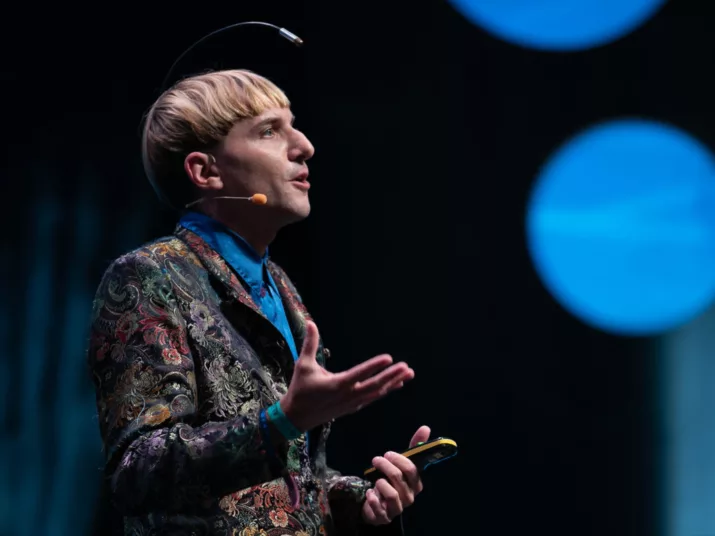
THINKING SPACE TECHNOLOGY
THE CYBORGS ARE HERE!
Some of the self-professed cyborgs – such as Manel Muñoz and Moon Ribas – have attained international fame as “human-machine beings”. In the following, we’ll introduce you to the two of them and to four others who’ve acquired extraordinary abilities.

Photo: Kai T. Dragland / NTNU, The Big Challenge Science Festival, CC BY 2.0, https://creativecommons.org/li...
Neil Harbisson
Neil Harbisson has had a computer chip implanted in his head. The sensor at the front of his forehead records colours, which the chip then converts from light waves into sound waves. In this way Harbisson – who used to see only black and white because of a sight defect – became the first person to be capable of “hearing” colours. In the meantime, the “Eyeborg” has received several updates – it’s even connected to the Internet – and Harbisson says he’s still very happy with it. For this reason, he fought hard – and successfully – for official permission to have the small antenna on his head pictured in his passport photo. As such, he is probably the world’s first person to be officially recognised as a cyborg. Only one thing has been bugging him since he became a cyborg: “During the Pokémon Go hype, lots of people wanted to catch me because of the antenna on my head.”
Photo: Kai T. Dragland / NTNU, The Big Challenge Science Festival, CC BY 2.0, https://creativecommons.org/li...
Moon Ribas
In 2013, Moon Ribas created a sensor, which she then had implanted in her feet. It reacts whenever an earthquake occurs somewhere in the world. The stronger the quake, the more the sensor vibrates. The artist has used the vibrations to create a dance performance called “Waiting for Earthquakes”, in which she places herself on stage – until an earthquake occurs somewhere in the world and her sensor starts vibrating. With her “Seismic Sense” she even claims to be able to sense moonquakes, and thus feels connected not only to the Earth, but also to space. Together with Neil Harbisson, she founded the first international cyborg foundation.
Photo: Harvard.2045 [CC BY-SA 4.0 (https://creativecommons.org/li...)]
Manel Muñoz
The Spaniard Manel Muñoz has had several sensors implanted in his body. They enable him to feel every little change in the air pressure around him. Depending on pressure levels, the sensors send small shocks into his head at different speeds. In this way, Muñoz can predict imminent changes in the weather with a fair degree of accuracy. And he also knows his height above sea level at any point in time. In 2016, he became artist in residence at the Cyborg Foundation; in 2017, he co-founded the Transpecies Society.
Photo: 3 May 2018, Berlin; Talk: Technology in the Body: Turning the Page by Means of Implants
Speaker: Enno Park; photo: Gregor Fischer / re:publica, CC BY 2.0, https://creativecommons.org/li...
Enno Park
Enno Park was 14 years old when he lost his ability to hear. Years later, he had two cochlear implants fitted into his head, which help him not only to hear but also to filter out distracting ambient noise. Not only can he now hear again – but can do so even better: “Today, I’m able to adapt my hearing to the environment.” In conversation situations, for example, he can filter out intrusive ambient noise; this has brought him to the point where he now hears things much more clearly than other people. “I’m talking about an expansion and improvement of the body,” says Park. He’s proud to be a cyborg, adding: “The term is actually old hat. But I still like to use it, because it expresses precisely what it’s all about.”
Photo: David Vintiner
Rob Spence
As a child, Rob Spence lost his eye in a shotgun accident. In 2007, he had his blind eye removed. Instead of a glass prosthesis, Spence now wears a wireless eye camera, which he uses to film his surroundings. He has developed several cameras. One of them shows off its technical inner workings, another is reminiscent of the film “Terminator” – it can glow red on command.
Photo: Kevin Warwick
Kevin Warwick
Kevin Warwick, a long-time professor of cybernetics at Reading University in the UK, was the first person to have a chip implanted in his body. He used it to open doors or to turn lights on and off. Around the same time, Warwick also arranged for the implantation of another device that was directly connected to his nervous system. It allowed him to control a robotic arm directly via neural signals.